System and method for vibration monitoring of a mining machine
Daniel , et al. June 1, 2
U.S. patent number 11,021,851 [Application Number 15/827,067] was granted by the patent office on 2021-06-01 for system and method for vibration monitoring of a mining machine. This patent grant is currently assigned to Joy Global Surface Mining Inc. The grantee listed for this patent is JOY GLOBAL SURFACE MINING INC. Invention is credited to Kenneth J. Daniel, Mark Emerson, Jose Torres.
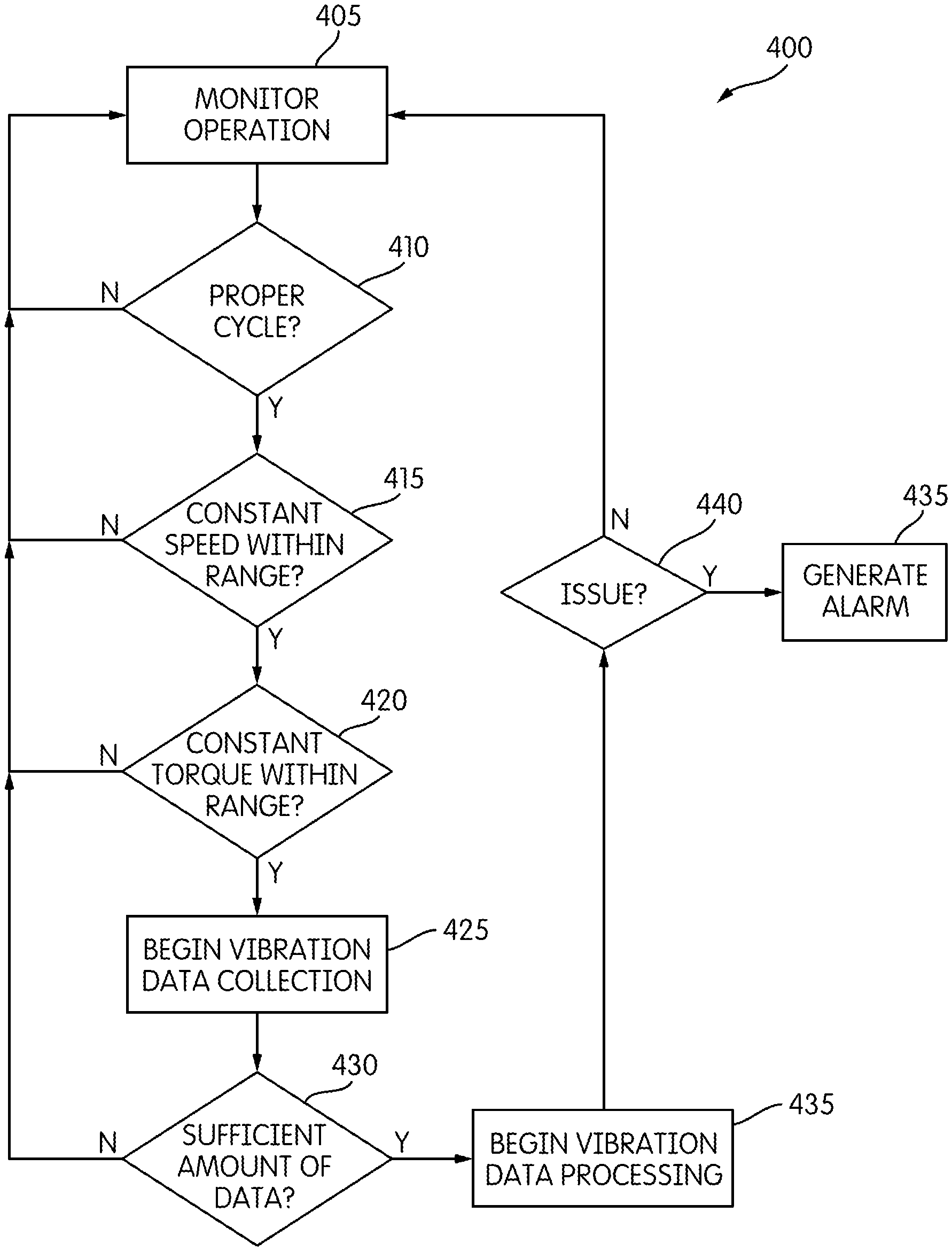
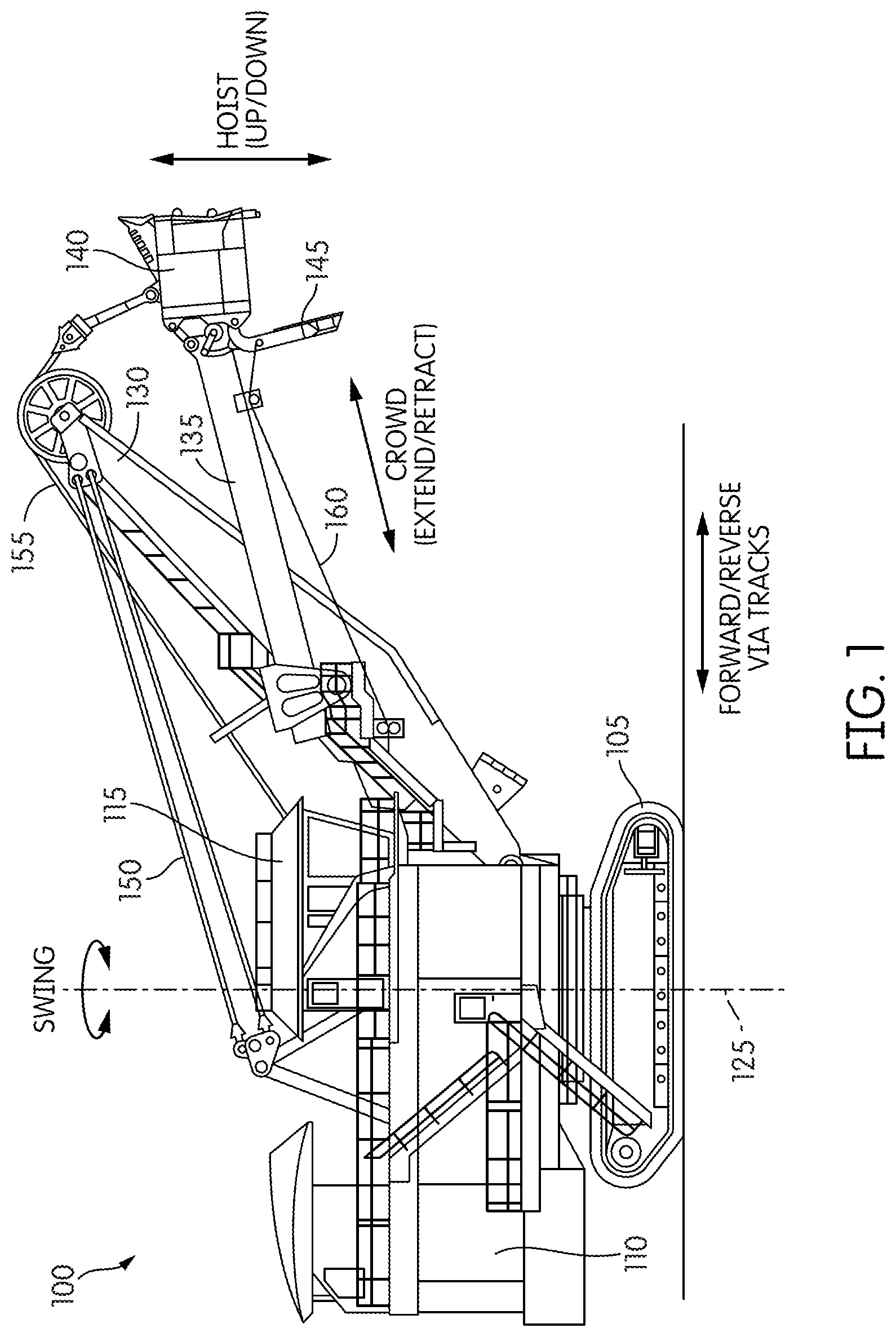
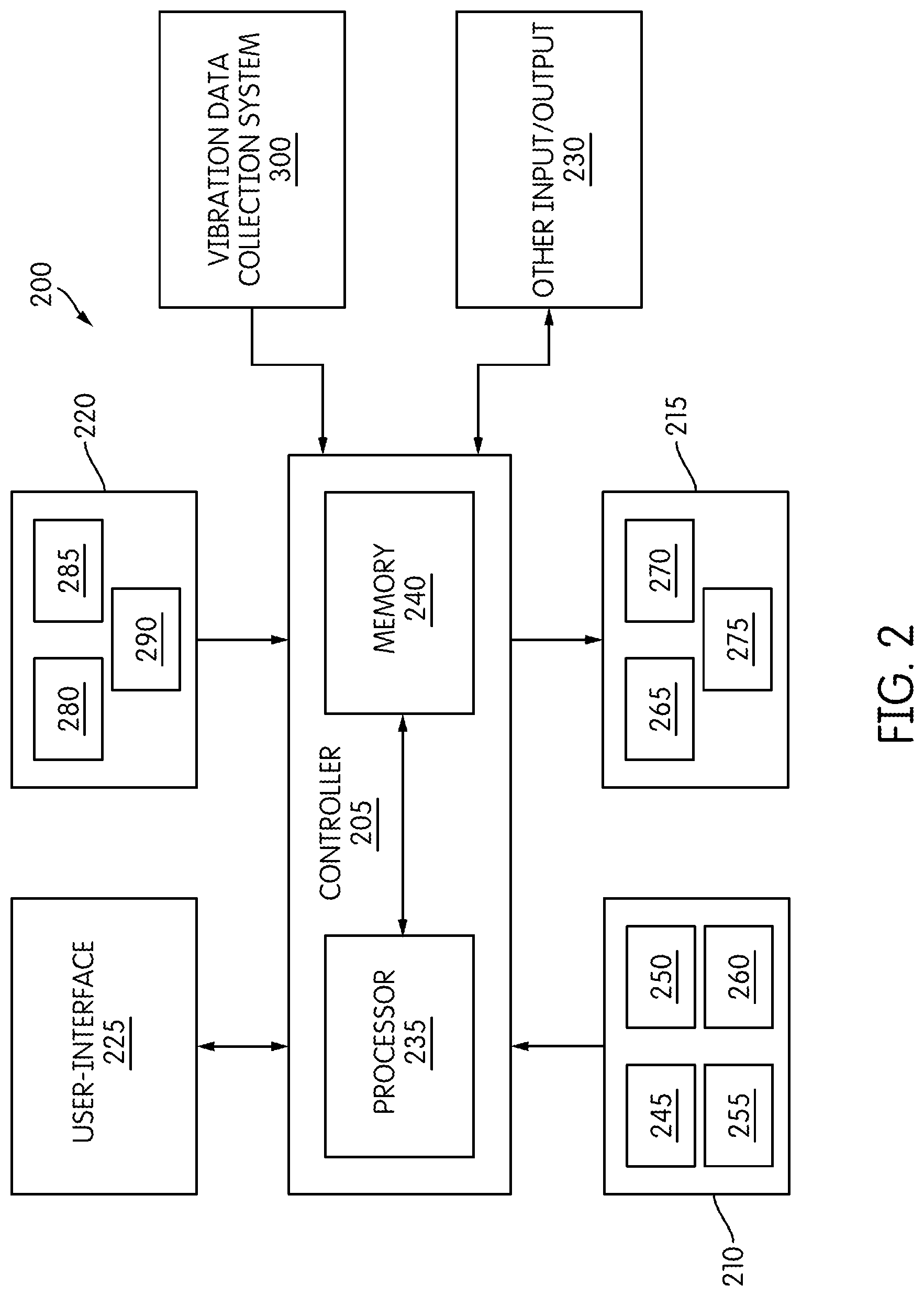
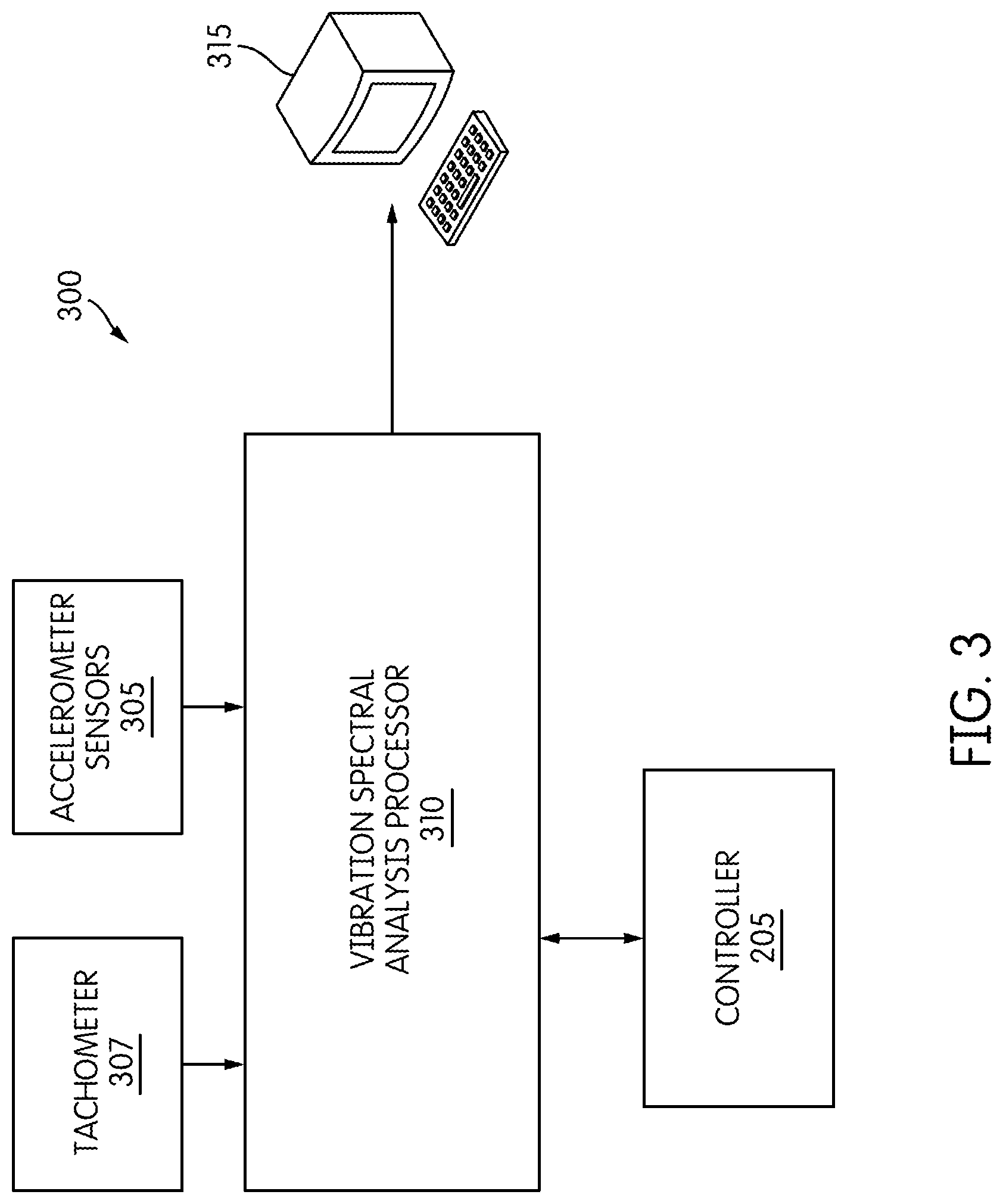
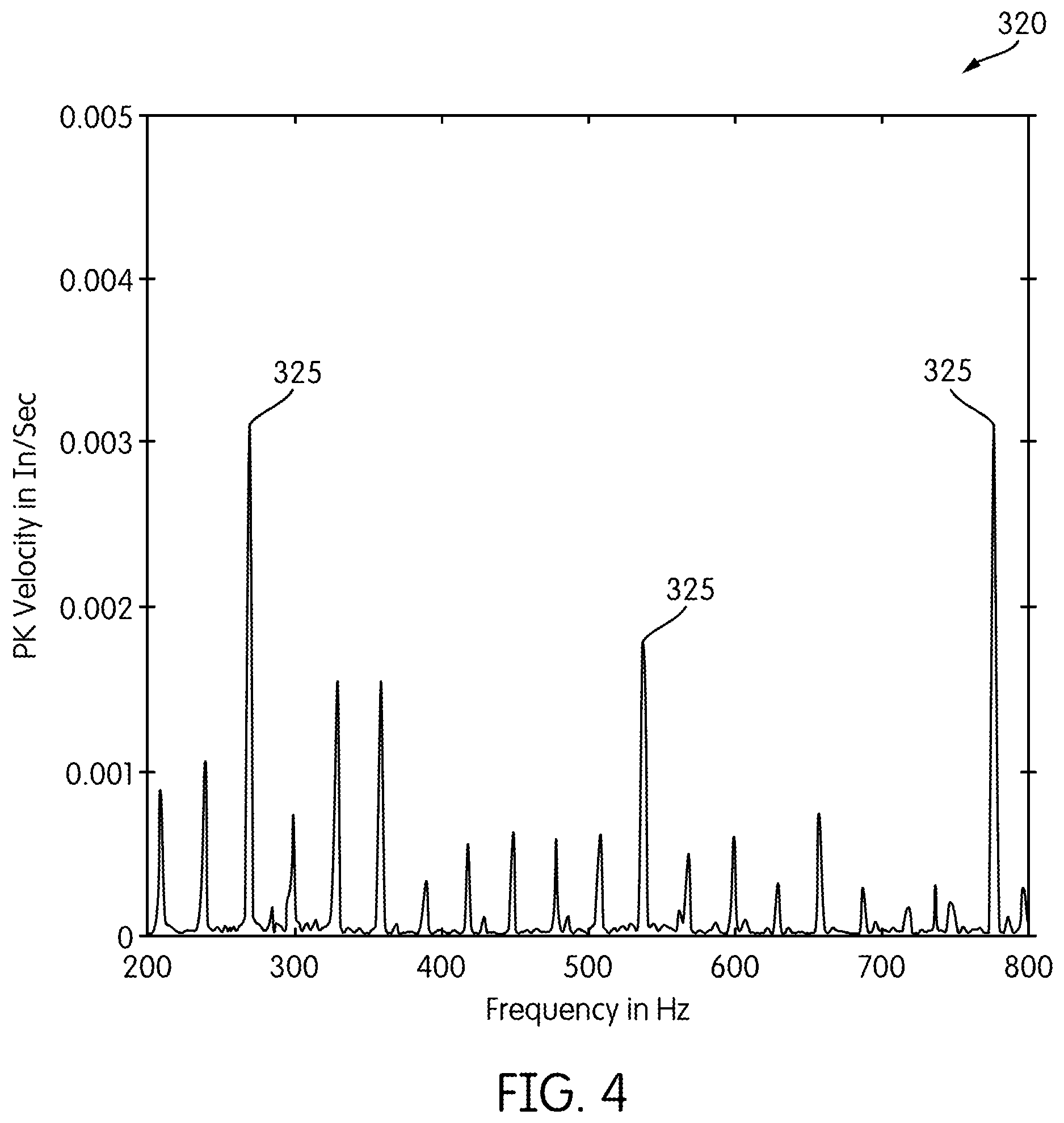
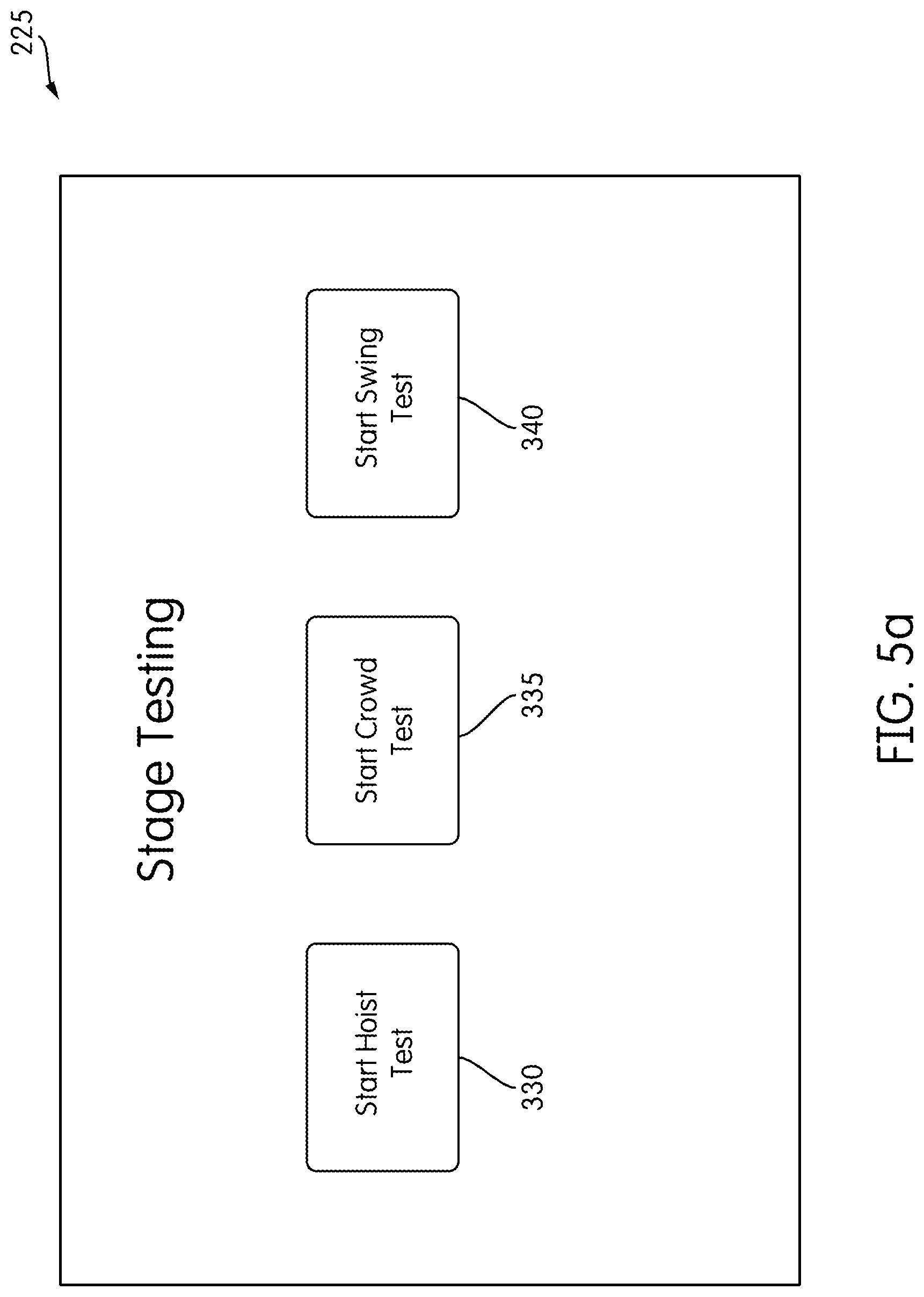
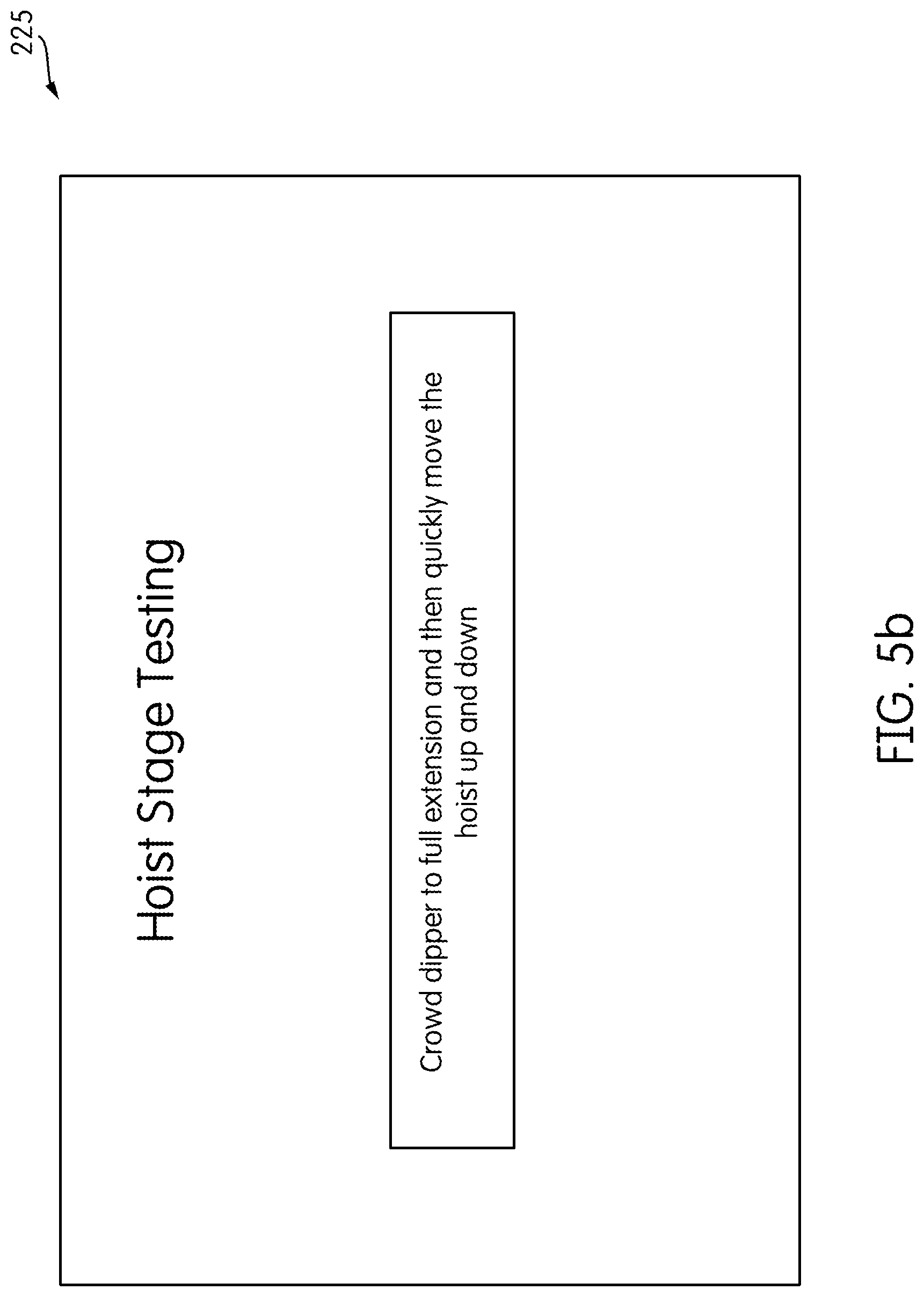
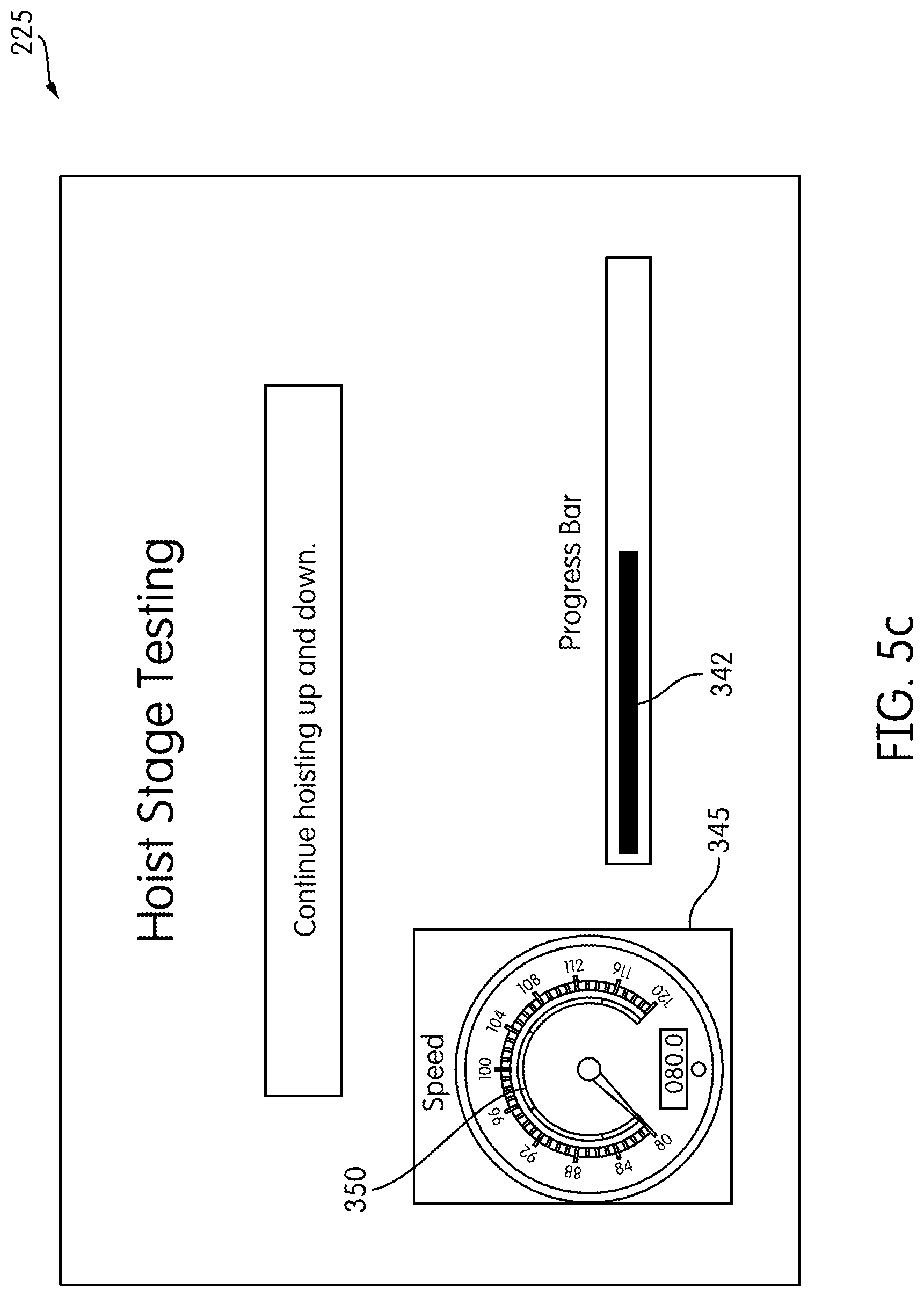
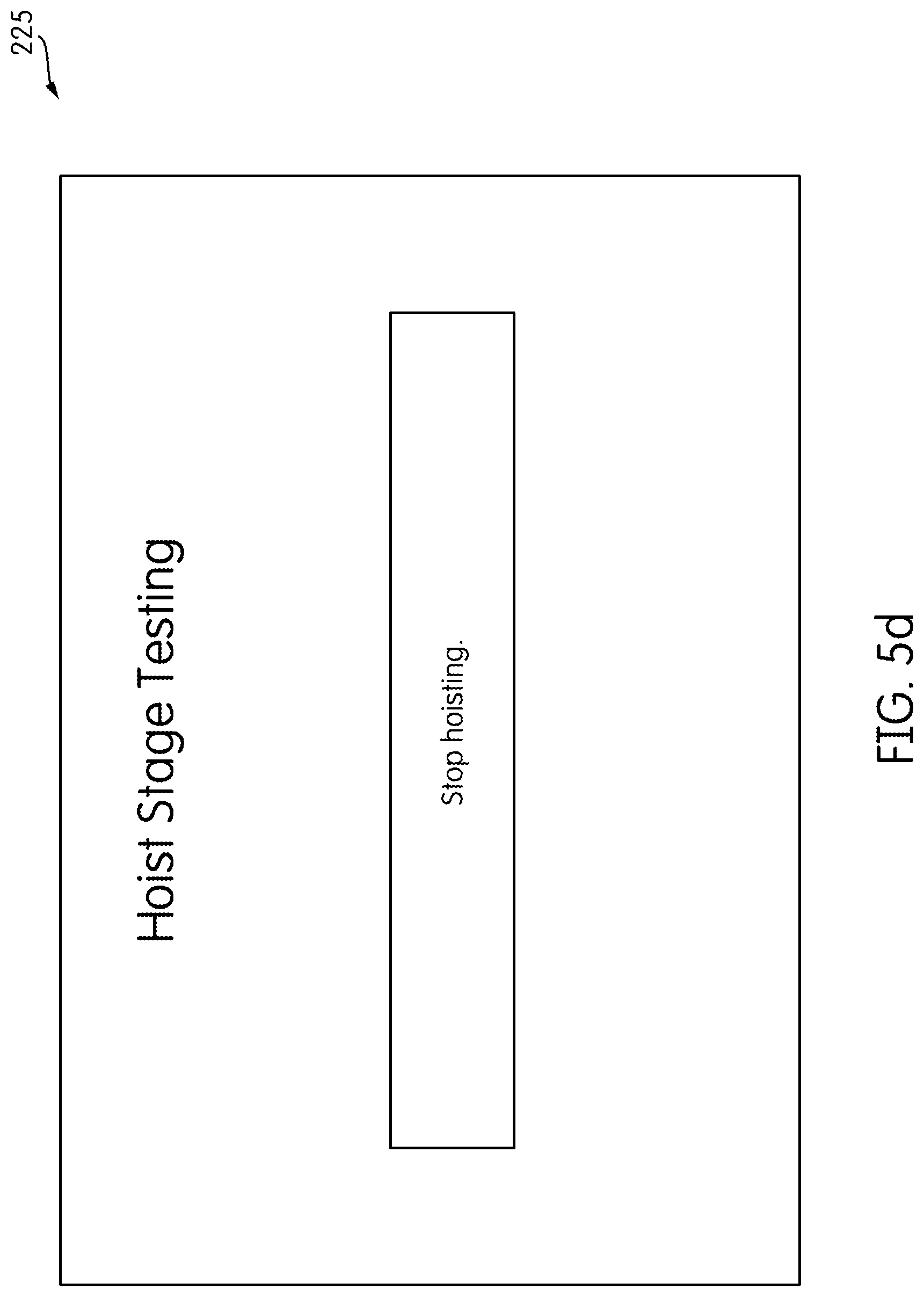
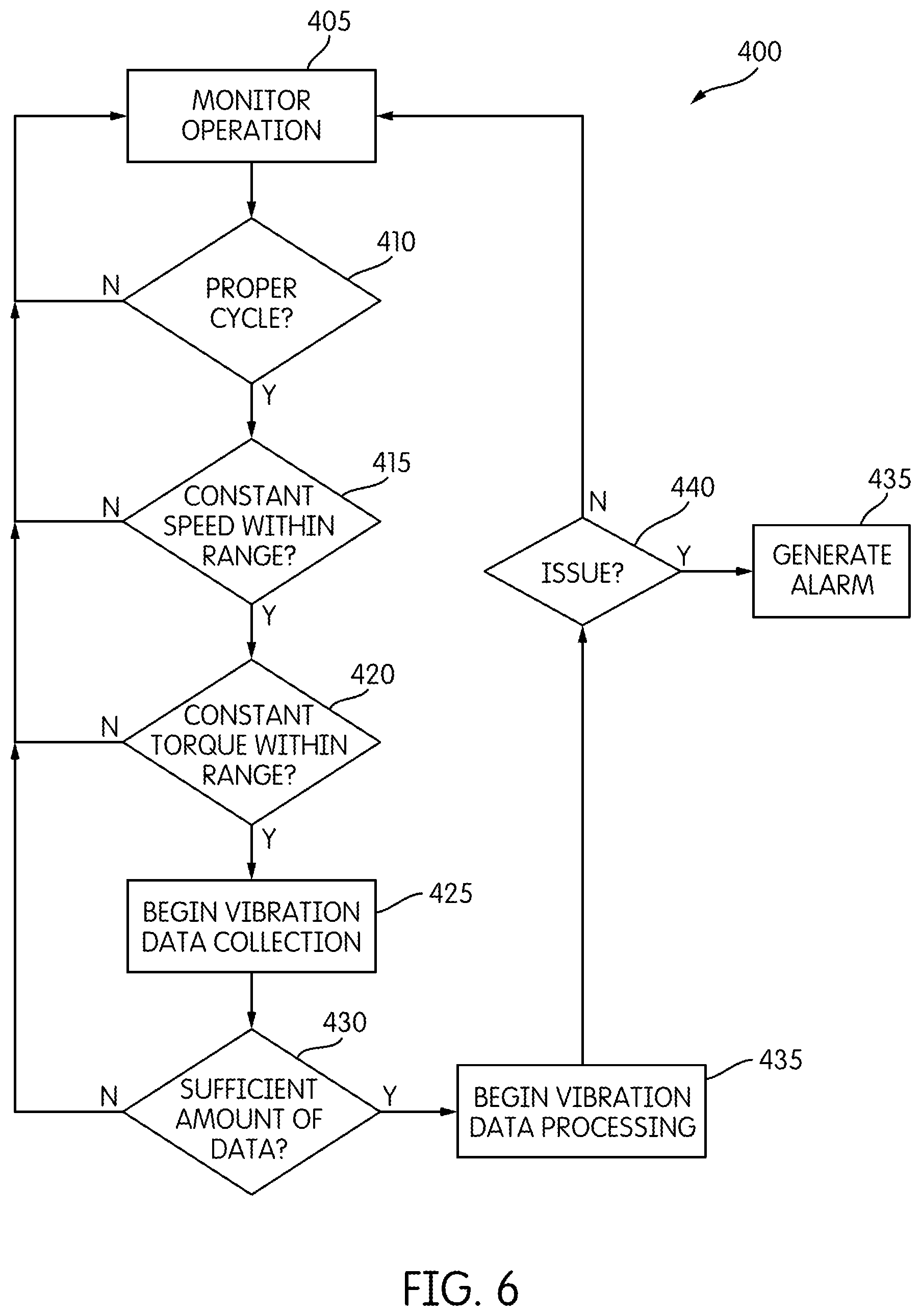
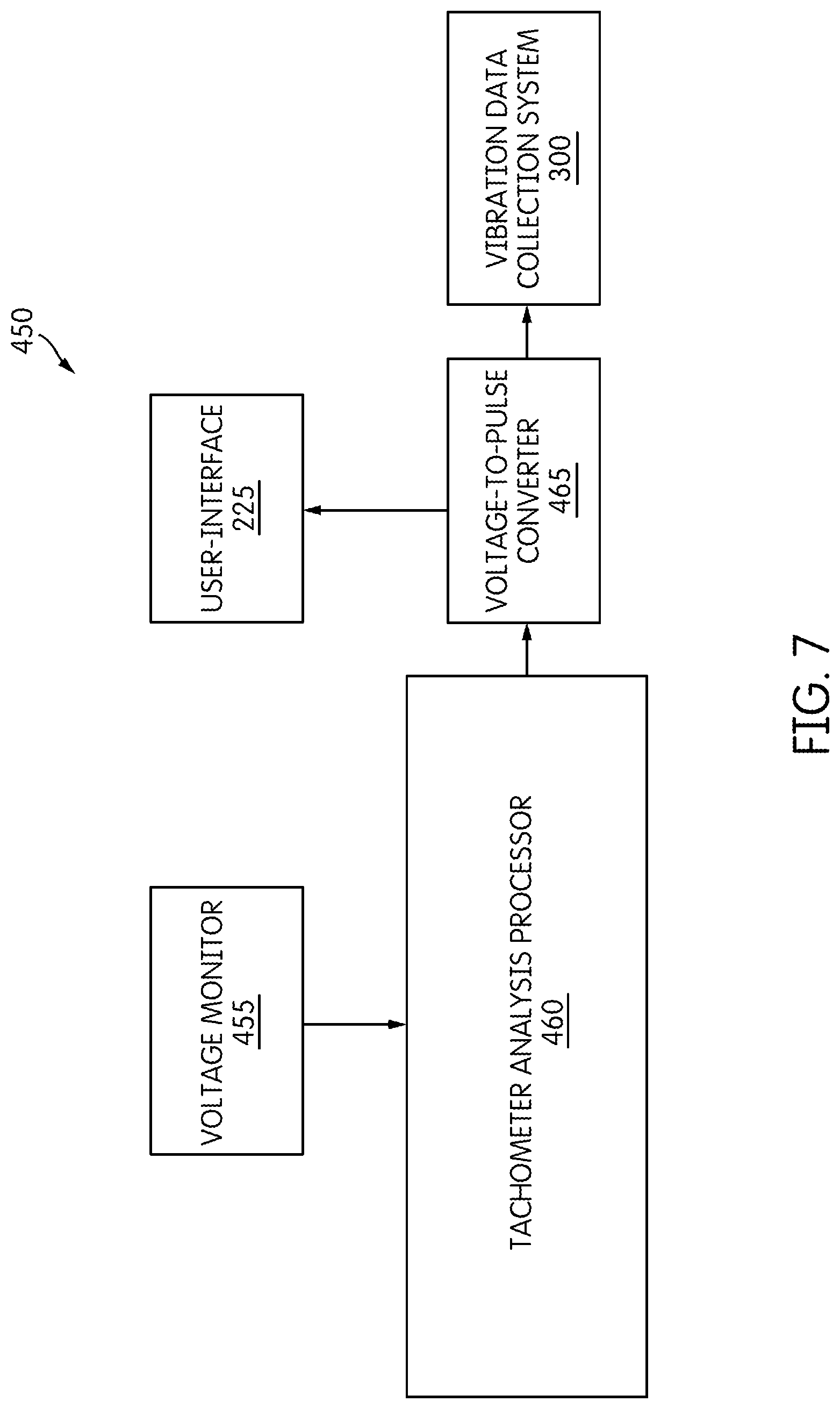
| United States Patent | 11,021,851 |
| Daniel , et al. | June 1, 2021 |
System and method for vibration monitoring of a mining machine
Abstract
A mining machine having a control system for operating the mining machine. The control system includes a vibration monitor. The mining machine further includes a sensor and a vibration control system. The sensor senses vibration of a component of the mining machine. The vibration control system determines when the mining machine is moving in a proper cycle, triggers acquisition of vibration sensor data from the sensor in response to determining that the mining machine is moving in the proper cycle, and outputs the vibration sensor data.
| Inventors: | Daniel; Kenneth J. (Libertyville, IL), Torres; Jose (Antofagasta, CL), Emerson; Mark (Germantown, WI) | ||||||||||
|---|---|---|---|---|---|---|---|---|---|---|---|
| Applicant: |
|
||||||||||
| Assignee: | Joy Global Surface Mining Inc
(Milwaukee, WI) |
||||||||||
| Family ID: | 1000005588808 | ||||||||||
| Appl. No.: | 15/827,067 | ||||||||||
| Filed: | November 30, 2017 |
Prior Publication Data
| Document Identifier | Publication Date | |
|---|---|---|
| US 20180080190 A1 | Mar 22, 2018 | |
Related U.S. Patent Documents
| Application Number | Filing Date | Patent Number | Issue Date | ||
|---|---|---|---|---|---|
| 13743894 | Jan 17, 2013 | 9903090 | |||
| 61587890 | Jan 18, 2012 | ||||
| 61594234 | Feb 2, 2012 | ||||
| Current U.S. Class: | 1/1 |
| Current CPC Class: | E02F 3/146 (20130101); G01M 7/00 (20130101); E02F 3/36 (20130101); E02F 9/267 (20130101); G06F 11/30 (20130101) |
| Current International Class: | E02F 3/36 (20060101); G06F 11/30 (20060101); E02F 3/14 (20060101); E02F 9/26 (20060101); G01M 7/00 (20060101) |
References Cited [Referenced By]
U.S. Patent Documents
| 3489013 | January 1970 | Spehr et al. |
| 4281876 | August 1981 | Lansberry |
| 4593566 | June 1986 | Ellis |
| 4655082 | April 1987 | Peterson |
| 5445028 | August 1995 | Bianchi |
| 5528208 | June 1996 | Kobayashi |
| 5895857 | April 1999 | Robinson et al. |
| 6062650 | May 2000 | Smith |
| 6351714 | February 2002 | Birchmeier |
| 6527130 | March 2003 | Ruddy |
| 6789025 | September 2004 | Boerhout |
| 6832521 | December 2004 | Courtney et al. |
| 7099782 | August 2006 | Hitchcock et al. |
| 7360844 | April 2008 | Frederick et al. |
| 7627441 | December 2009 | Longsdorf et al. |
| 7686400 | March 2010 | Frederick et al. |
| 7695071 | April 2010 | Jackson et al. |
| 7887142 | February 2011 | Hall et al. |
| 7930111 | April 2011 | Luo |
| 8016363 | September 2011 | Jackson |
| 8061782 | November 2011 | Hall et al. |
| 8172334 | May 2012 | Lindbergh et al. |
| 8174402 | May 2012 | Bouse et al. |
| 8930120 | January 2015 | Kwon |
| 9903090 | February 2018 | Daniel et al. |
| 2002/0144968 | October 2002 | Ruddy |
| 2003/0130811 | July 2003 | Boerhout |
| 2004/0199348 | October 2004 | Hitchcock |
| 2004/0207247 | October 2004 | Jackson et al. |
| 2005/0034902 | February 2005 | Madhavarao et al. |
| 2006/0081399 | April 2006 | Jones |
| 2008/0025367 | January 2008 | Nakatani |
| 2008/0201706 | August 2008 | Nordtvedt |
| 2008/0201728 | August 2008 | Midttun |
| 2008/0314641 | December 2008 | McClard |
| 2009/0164142 | June 2009 | Studer |
| 2010/0063691 | March 2010 | Hall et al. |
| 2010/0065290 | March 2010 | Hall et al. |
| 2010/0109417 | May 2010 | Jackson et al. |
| 2012/0072136 | March 2012 | Hedin |
| 2012/0130693 | May 2012 | Ertas |
| 2013/0184927 | July 2013 | Daniel |
| 2013/0197721 | August 2013 | Gu |
| 2018/0164149 | June 2018 | Hedin |
| 20801327 | Aug 2008 | CL | |||
| 2797780 | Jul 2006 | CN | |||
| 101441464 | May 2009 | CN | |||
| 101867604 | Oct 2010 | CN | |||
| 101963797 | Feb 2011 | CN | |||
| 101975672 | Feb 2011 | CN | |||
| 201993166 | Sep 2011 | CN | |||
Other References
|
Ofice Action issued from the Canadian Patent Office for related Application No. 2,802,343 dated Aug. 21, 2018 (4 pages). cited by applicant . Office Action dated Jun. 7, 2019 by the Canadian Intellectual Property Office for Application No. 2802343 (3 pages). cited by applicant . Chilean Intellectual Property Office Action for Application 201600747 dated Feb. 2, 2018 (8 pages which includes Statement of Relevance). cited by applicant . Chinese Patent Office Action Decision of Reexamination for Application No. 201310079425.1 dated Jul. 17, 2019 (14 pages including statement of relevance). cited by applicant . Office Action dated Mar. 21, 2019 by the Chinese Patent Office for related Application No. 201310079425.1 (14 pages, English translation included). cited by applicant . Emerson Process Management. "Now You Have a Choice, The CSI 6500 Upgrade Program," CSI 6500 Machinery Health Monitor, specification sheet, (2011) 2 pages, www.assetweb.com/mhm, Knoxville. cited by applicant . Emerson Process Management, "Case Seismic Vibration Monitor Specifications," CSI 6500 Machinery Health Monitor, specification sheet (2011) 5 pages, www.assetweb.com/mhm, Knoxville. cited by applicant . Emerson Process Management, "Speed and Key Monitor Specifications," CSI 6500 Machinery Health Monitor, specification sheet (2011) 6 pages, www.assetweb.com/mhm, Knoxville. cited by applicant . Emerson Process Management, "16-Channel Output Relay Module Specificaitons," CSI 6500 Machinery Health Monitor, specification sheet (2011) 4 pages, www.assetweb.com/mhm, Knoxville. cited by applicant . Emerson Process Management, "Shaft Absolute Vibration Monitor Specifications," CSI 6500 Machinery Health Monitor, specification sheet (2011) 5 pages, www.assetweb.com/mhm, Knoxville. cited by applicant . Emerson Process Management, "Case Piezoelectric Vibration Monitor Specifications," CSI 6500 Machinery Health Monitor, specification sheet (2011) 5 pages, www.assetweb.com/mhm, Knoxville. cited by applicant . Emerson Process Management, "Predictive Diagnostics from Rotation Equipment Prevent Unscheduled Downtime," Online Machinery Health Management, specification sheet (2011) 2 pages, www.assetweb.com/mhm, Knoxville. cited by applicant . First Office Action from the State Intellectual Property Office of China for Application No. 201320112934.5 dated Jun. 5, 2013 (4 pages, which includes a Statement of Relevance). cited by applicant . Second Office Action from the State Intellectual Property Office of China for Application No. 201320112934.5 dated Nov. 28, 2013 (3 pages, which includes a Statement of Relevance). cited by applicant . First Office Action from the Australian Patent Office for Application No. 2013200326 dated Apr. 22, 2014 (4 pages). cited by applicant . First Office Action from the Australian Patent Office for Application No. 2014233575 dated Jul. 10, 2015 (3 pages). cited by applicant . First Office Action from the State Intellectual Property Office of China for Application No. 201310079425.1 dated Dec. 17, 2015 (18 pages). cited by applicant . First Office Action from the Chilean Intellectual Property Office for Application No. 0180-2013, first known to us Feb. 1, 2016, (13 pages, which includes English Statement of Relevance). cited by applicant . Second Office Action from the Chilean Intellectual Property Office for Application No. 0180-2013, first known to us Jul. 20, 2016, (15 pages, which includes English Statement of Relevance). cited by applicant . Second Office Action from the State Intellectual Property Office of China for Application No. 201310079425.1 dated Aug. 30, 2016 (9 pages). cited by applicant . Chinese Patent Office Action for Application No. 20130079425.1 dated Aug. 24, 2017 (11 pages English Translation Included). cited by applicant . Chilean Intellectual Property Office Action for Application 201600747 dated Aug. 25, 2017 (8 pages which includes English Statement of Relevance). cited by applicant . Declaration of Kenneth Daniel PH.D. for U.S. Appl. No. 13/743,894 dated Nov. 21, 2016, (2 pages). cited by applicant . Second Office Action from the State Intellectual Property Office of China for Application No. 201310079425.1 dated Mar. 10, 2017 (14 pages). cited by applicant . Chinese Decision of Rejections from the State Intellectual Property Office for Application No. 201310079425.1 dated Jan. 24, 2018 (10 pages with English translation). cited by applicant . Office Action issued by the China National Intellectual Property Administration for Application No. 201910982239.6 dated Sep. 22, 2020 (20 pages including English translation). cited by applicant . Ye Fang-Yong et al., "Design of Monitoring and Mechanical Fault Diagnosis Systems Design for Roadheader," Coal Mine Machinery, 2009, vol. 30, No. 7, pp. 205-207. cited by applicant. |
Primary Examiner: Mawari; Redhwan K
Attorney, Agent or Firm: Michael Best & Friedrich LLP
Parent Case Text
RELATED APPLICATIONS
The present application claims priority to U.S. patent application Ser. No. 13/743,894, filed Jan. 17, 2013, which claims priority to U.S. Provisional Application 61/587,890, filed Jan. 18, 2012, and U.S. Provisional Application 61/594,234, filed Feb. 2, 2012, the entire contents of which are hereby incorporated
Claims
What is claimed is:
1. A mining machine having a control system for operating the mining machine, the control system having a vibration monitor, the mining machine comprising: a sensor configured to sense a vibration of a component of the mining machine; and a vibration control system having a processor, the vibration control system configured to determine when the mining machine is moving in a proper cycle, trigger an acquisition of vibration sensor data from the sensor in response to determining that the mining machine is moving in the proper cycle and that the component is moving at a constant speed within a predefined speed range, and output the vibration sensor data.
2. The mining machine of claim 1, wherein the sensor is an accelerometer.
3. The mining machine of claim 1, further comprising a tachometer that monitors a speed of the mining machine while operating in the proper cycle.
4. The mining machine of claim 3, wherein the tachometer is a simulated tachometer including a voltage monitor.
5. The mining machine of claim 1, further comprising a user-interface that indicates an amount of the vibration sensor data collected.
6. The mining machine of claim 1, further including a network for communicating the vibration sensor data.
7. The mining machine of claim 6, wherein the vibration sensor data is displayed at a remote location.
8. The mining machine of claim 1, wherein the vibration control system further monitors a torque of the component of the mining machine and obtains the vibration sensor data further based on determining that the component has a constant torque within a predefined range.
9. The mining machine of claim 1, wherein the proper cycle is at least one of a digging operation, a swinging operation, and a tucking operation.
10. The mining machine of claim 1, wherein the vibration control system further obtains the vibration sensor data from the sensor upon determining a torque of the component of the mining machine is within a predefined torque range.
11. The mining machine of claim 1, wherein the vibration control system further comprises generating an alarm when the vibration sensor data indicates a mechanical issue with the component of the mining machine.
12. A method for monitoring mining equipment, the method comprising: monitoring an operation of a mining machine; determining that a component of the mining machine is moving in a proper cycle; triggering, by a processor, an acquisition of vibration sensor data of the mining machine from a vibration sensor in response to determining that the component of the mining machine is moving in the proper cycle and that the component is moving at a constant speed within a predefined speed range; and outputting the vibration data.
13. The method of claim 12, further including determining that the component of the mining machine is moving with a constant torque.
14. The method of claim 13, wherein the component of the mining machine is moving with the constant torque within a predefined range.
15. The method of claim 12, further comprising obtaining, by the processor, vibration sensor data from the vibration sensor upon determining a torque of the component of the mining machine is within a predefined torque range.
16. A mining machine having a control system for operating the mining machine, the control system having a vibration monitor, the mining machine comprising: a user-interface configured to provide user-perceptible instructions to a user to operate a component of the mining machine in a predetermined pattern; a sensor configured to sense a vibration of the component of the mining machine while the component operates in the predetermined pattern, the sensor further configured to output vibration sensor data; and a processor configured to acquire the vibration sensor data from the sensor, wherein an acquisition of the vibration sensor data is triggered in response to the component moving at a constant speed within a predefined speed range while the component operates in the predetermined pattern, process the vibration sensor data, and output the processed vibration data.
17. The mining machine of claim 16, wherein the predetermined pattern includes at least one selected from the group consisting of a hoisting action, a crowding action, and a swinging action.
18. The mining machine of claim 16, wherein the component is at least one selected from the group consisting of a dipper shaft, a handle, and a dipper.
19. A mining machine having a control system for operating the mining machine, the mining machine comprising: a user-interface configured to provide user-perceptible instructions to a user to operate the mining machine in a predetermined pattern; a sensor configured to sense a parameter of the mining machine while the mining machine operates in the predetermined pattern, the sensor further configured to output vibration sensor data representing the sensed parameter, wherein the parameter is a vibration; and a processor configured to acquire the vibration sensor data from the sensor, wherein an acquisition of the vibration sensor data is triggered in response to a component of the mining machine moving at a constant speed within a predefined speed range while the mining machine operates in the predetermined pattern, process the vibration sensor data, and output the processed vibration sensor data.
20. The mining machine of claim 19, wherein the parameter sensed further includes a torque or a speed.
21. The mining machine of claim 19, wherein the sensor is an accelerometer that senses the vibration.
22. The mining machine of claim 19, further comprising a tachometer that monitors a speed of the mining machine while operating in the predetermined pattern.
23. The mining machine of claim 22, wherein the tachometer is a simulated tachometer including a voltage monitor.
24. The mining machine of claim 19, wherein the predetermined pattern is at least one of moving a hoist up and down, moving a crowd in and out, and swinging a handle side to side.
25. The mining machine of claim 19, wherein processing the vibration sensor data includes performing a Fourier transform on the vibration sensor data.
26. The mining machine of claim 19, wherein the user-interface further indicates at least one of an amount of the vibration sensor data collected and the processed vibration sensor data outputted by the processor.
27. The mining machine of claim 19, wherein the mining machine is moved in the predetermined pattern until an amount of collected vibration sensor data exceeds a threshold.
28. The mining machine of claim 19, further including a network for communicating the processed vibration sensor data outputted by the processor.
29. The mining machine of claim 28, wherein the processed vibration sensor data is displayed at a remote location.
Description
BACKGROUND
The application relates to vibration monitoring for electric mining shovels. Two conventional types of vibration monitoring and analysis on mining machines include manual testing and primitive operational monitoring. Manual testing involved placing mining machines off-line and interrupting regular mining operations. Then, personnel would secure one or two vibration sensors on or near one or more moving components of the to-be-analyzed mining machine. The personnel would then instruct the operator of the mining machine to operate the mining machine in a particular way in order to capture vibration data. Thereafter, the captured data would be analyzed for diagnostic purposes. Manual testing was a labor intensive activity that required a high level of expertise for placement of vibration data sensors, vibration data collection, and vibration data analysis. Additionally, manual testing required interruption of mining operations for several hours. Primitive operational monitoring involved installing a vibration monitor for capture of vibration data during operation of the mining machine. The capture of vibration data was initiated based on two factors, motor speed and motor rotation direction. The capture of vibration data was not based on the shovel's operating cycle, but rather simply motor speed and rotational direction. This technique resulted not only in inefficient and inconsistent data capture, but collected vibration data that was difficult to analyze.
SUMMARY
Vibration monitoring enables monitoring of the overall bearing and shaft health of an electric mining shovel.
One embodiment provides a mining machine having a control system for operating the mining machine. The control system includes a vibration monitor. The mining machine further includes a sensor and a vibration control system. The sensor senses vibration of a component of the mining machine. The vibration control system determines when the mining machine is moving in a proper cycle, triggers acquisition of vibration sensor data from the sensor in response to determining that the mining machine is moving in the proper cycle, and outputs the vibration sensor data.
Another embodiment provides a method for monitoring mining equipment. The method including monitoring operation of a mining machine, and determining that a component of the mining machine is moving in a proper cycle. The method further including triggering, by a processor, the acquisition of vibration data of the mining machine in response to determining that the component of the mining machine is moving in the proper cycle, and outputting the vibration data.
Another embodiment provides a mining machine having a control system for operating the mining machine. The control system including a vibration monitor. The mining machine including a user-interface, a sensor, and a processor. The user-interface provides instructions to operate a component of the mining machine in a predetermined pattern. The sensor senses vibration of the component of the mining machine while the component operates in the predetermined pattern, the sensor outputting vibration sensor data. The processor receives the vibration sensor data from the sensor, processes the vibration sensor data, and outputs the processed vibration data.
Yet another embodiment provides mining machine having a control system for operating the mining machine. The mining machine includes a user-interface, a sensor, and a processor. The user-interface provides instructions to operate the mining machine in a predetermined pattern. The sensor senses a parameter of the mining machine while the mining machine operates in the predetermined pattern, and outputs sensor data representing the sensed parameter. The processor receives the sensor data from the sensor, processes the sensor data, and outputs the processed sensor data.
In some embodiments, the application includes a mining machine including a simulated tachometer and a vibration monitoring module. The simulated tachometer may include a voltage monitor, or a voltage monitor and a voltage-to-pulse converter, which are used to determine a speed of a component of the mining machine to generate sensed speed, which is outputted to the vibration module. The vibration module senses vibrations of the component of the mining machine, based on the sensed speed, and generates vibration data. The vibration module then processes the vibration data to generate a spectral waveform. The processing may include a Fourier transform and may be based in part on the sensed speed to adjust for variations in the speed of the component during collection of the vibration data. The component may be one of a hoist motor, crowd motor, swing motor, hoist gearbox, crowd gearbox, and swing gearbox.
Other aspects of the application will become apparent by consideration of the detailed description and accompanying drawings.
BRIEF DESCRIPTION OF THE DRAWINGS
FIG. 1 illustrates an electric mining shovel.
FIG. 2 illustrates a block diagram of a control system of the mining shovel of FIG. 1.
FIG. 3 illustrates a block diagram of a vibration data collection system of the mining shovel.
FIG. 4 illustrates a vibration spectrum analysis.
FIGS. 5a-5d illustrate a user-interface of the control system.
FIG. 6 illustrates a process of collecting vibration data.
FIG. 7 illustrates a simulated tachometer of the mining shovel.
DETAILED DESCRIPTION
Before any embodiments of the application are explained in detail, it is to be understood that the application is not limited in its application to the details of construction and the arrangement of components set forth in the following description or illustrated in the following drawings. The application is capable of other embodiments and of being practiced or of being carried out in various ways. Also, it is to be understood that the phraseology and terminology used herein is for the purpose of description and should not be regarded as limiting. The use of "including," "comprising" or "having" and variations thereof herein is meant to encompass the items listed thereafter and equivalents thereof as well as additional items. The terms "mounted," "connected" and "coupled" are used broadly and encompass both direct and indirect mounting, connecting and coupling. Further, "connected" and "coupled" are not restricted to physical or mechanical connections or couplings, and can include electrical connections or couplings, whether direct or indirect. Also, electronic communications and notifications may be performed using any known means including direct connections, wireless connections, etc.
It should also be noted that a plurality of hardware and software based devices, as well as a plurality of different structural components may be used to implement the application. In addition, it should be understood that embodiments of the application may include hardware, software, and electronic components or modules that, for purposes of discussion, may be illustrated and described as if the majority of the components were implemented solely in hardware. However, one of ordinary skill in the art, and based on a reading of this detailed description, would recognize that, in at least one embodiment, the electronic based aspects of the application may be implemented in software (e.g., stored on non-transitory computer-readable medium) executable by one or more processors. As such, it should be noted that a plurality of hardware and software based devices, as well as a plurality of different structural components may be utilized to implement the application. Furthermore, and as described in subsequent paragraphs, the specific mechanical configurations illustrated in the drawings are intended to exemplify embodiments of the application and that other alternative mechanical configurations are possible. For example, "controllers" described in the specification can include standard processing components, such as one or more processors, one or more computer-readable medium modules, one or more input/output interfaces, and various connections (e.g., a system bus) connecting the components.
FIG. 1 illustrates an electric mining shovel 100. The embodiment shown in FIG. 1 illustrates the electric mining shovel 100 as a rope shovel, however in other embodiments the electric mining shovel 100 can be a different type of mining machine, for example, a hybrid mining shovel, a dragline excavator, etc. The mining shovel 100 includes tracks 105 for propelling the rope shovel 100 forward and backward, and for turning the rope shovel 100 (i.e., by varying the speed and/or direction of the left and right tracks relative to each other). The tracks 105 support a base 110 including a cab 115. The base 110 is able to swing or swivel about a swing axis 125, for instance, to move from a digging location to a dumping location. Movement of the tracks 105 is not necessary for the swing motion. The rope shovel further includes a dipper shaft 130 supporting a pivotable dipper handle 135 (handle 135) and dipper 140. The dipper 140 includes a door 145 for dumping contents from within the dipper 140 into a dump location, such as a hopper or dump-truck.
The rope shovel 100 also includes taut suspension cables 150 coupled between the base 110 and dipper shaft 130 for supporting the dipper shaft 130; a hoist cable 155 attached to a winch (not shown) within the base 110 for winding the cable 155 to raise and lower the dipper 140; and a dipper door cable 160 attached to another winch (not shown) for opening the door 145 of the dipper 140. In some instances, the rope shovel 100 is a P&H.RTM. 4100 series shovel produced by P&H Mining Equipment Inc., although the electric mining shovel 100 can be another type or model of electric mining equipment.
When the tracks 105 of the mining shovel 100 are static, the dipper 140 is operable to move based on three control actions, hoist, crowd, and swing. The hoist control raises and lowers the dipper 140 by winding and unwinding hoist cable 155. The crowd control extends and retracts the position of the handle 135 and dipper 140. In one embodiment, the handle 135 and dipper 140 are crowded by using a rack and pinion system. In another embodiment, the handle 135 and dipper 140 are crowded using a hydraulic drive system. The swing control swivels the handle 135 relative to the swing axis 125. Before dumping its contents, the dipper 140 is maneuvered to the appropriate hoist, crowd, and swing positions to 1) ensure the contents do not miss the dump location; 2) the door 145 does not hit the dump location when released; and 3) the dipper 140 is not too high such that the released contents would damage the dump location.
As shown in FIG. 2, the mining shovel 100 includes a control system 200. The control system 200 includes a controller 205, operator controls 210, dipper controls 215, sensors 220, a user-interface 225, and other input/outputs 230. The controller 205 includes a processor 235 and memory 240. The memory 240 stores instructions executable by the processor 235 and various inputs/outputs for, e.g., allowing communication between the controller 205 and the operator or between the controller 205 and sensors 220. In some instances, the controller 205 includes one or more of a microprocessor, digital signal processor (DSP), field programmable gate array (FPGA), application specific integrated circuit (ASIC), or the like.
The controller 205 receives input from the operator controls 210. The operator controls 210 include a crowd control 245, a swing control 250, a hoist control 255, and a door control 260. The crowd control 245, swing control 250, hoist control 255, and door control 260 include, for instance, operator controlled input devices such as joysticks, levers, foot pedals, and other actuators. The operator controls 210 receive operator input via the input devices and output digital motion commands to the controller 205. The motion commands include, for example, hoist up, hoist down, crowd extend, crowd retract, swing clockwise, swing counterclockwise, dipper door release, left track forward, left track reverse, right track forward, and right track reverse.
Upon receiving a motion command, the controller 205 generally controls dipper controls 215 as commanded by the operator. The dipper controls 215 include one or more crowd motors 265, one or more swing motors 270, and one or more hoist motors 275. For instance, if the operator indicates via swing control 250 to rotate the handle 135 counterclockwise, the controller 305 will generally control the swing motor 270 to rotate the handle 135 counterclockwise. However, in some embodiments of the application the controller 205 is operable to limit the operator motion commands and generate motion commands independent of the operator input.
The controller 205 is also in communication with a number of sensors 220 to monitor the location and status of the dipper 140. For example, the controller 205 is in communication with one or more crowd sensors 280, one or more swing sensors 285, and one or more hoist sensors 290. The crowd sensors 280 indicate to the controller 205 the level of extension or retraction of the dipper 140. The swing sensors 285 indicate to the controller 205 the swing angle of the handle 135. The hoist sensors 290 indicate to the controller 205 the height of the dipper 140 based on the hoist cable 155 position. In other embodiments there are door latch sensors which, among other things, indicate whether the dipper door 145 is open or closed and measure weight of a load contained in the dipper 140
The user-interface 225, such as an operator user-interface, provides information to the operator about the status of the mining shovel 100 and other systems communicating with the mining shovel 100. The user-interface 225 includes one or more of the following: a display (e.g. a liquid crystal display (LCD)); one or more light emitting diodes (LEDs) or other illumination devices; a heads-up display (e.g., projected on a window of the cab 115); speakers for audible feedback (e.g., beeps, spoken messages, etc.); tactile feedback devices such as vibration devices that cause vibration of the operator's seat or operator controls 210; or another feedback device.
FIG. 3 illustrates a block diagram of a vibration data collection system 300 of the mining shovel 100. The vibration data collection system 300 includes one or more accelerometer sensors 305, one or more tachometers 307, a vibration spectral analysis processor 310, and a server 315. The data collection system 300 is further electrically coupled to the controller 205.
The accelerometer sensors 305 collect vibration data of the mining shovel 100 while the mining shovel 100 is in operation. The accelerometer sensors 305 measure vibrations of a structure. The force caused by vibrations causes a force onto the piezoelectric material within the accelerometer sensors 305. The piezoelectric material produces an electric charge which is proportional to the force exerted upon it. The accelerometer sensors 305 may be radial accelerometer sensors or axial accelerometer sensors. The radial accelerometer sensors measure the acceleration on bearings of the mining shovel 100. The axial accelerometer sensors measure the acceleration on shafts of the mining shovel 100. The accelerometer sensors 305 are located at various locations on the mining shovel 100 including, among other locations, the one or more crowd motors 265, the one or more swing motors 270, the one or more hoist motors 275, a hoist gearbox, a crowd gearbox, and a swing gearbox.
The tachometers 307 measure the rotational speed of the various motors of the mining shovel 100. Each tachometer 307 can either be a physical tachometer or a simulated tachometer. A physical tachometer is an instrument that physically measures the rotational speed of a motor for example, using a optical or a magnetic sensor. Simulated tachometers are described in more detail below.
The vibration spectral analysis processor 310 processes vibration data from the accelerometer sensors 305 and outputs processed vibration data. In some embodiments the vibration spectral analysis processor 310 outputs the raw vibration data along with the processed vibration data. The vibration spectral analysis processor 310 includes a processor and memory. The processor executes instructions stored on the memory for analyzing and processing the received data from the accelerometer sensors 305. In some instances the vibration spectral analysis processor 310 is a microprocessor, digital signal processor (DSP), field programmable gate array (FPGA), application specific integrated circuit (ASIC), or the like. In some embodiments, the vibration spectral analysis processor 310 processes the vibration data by creating a sound file of the vibration data. The vibration spectral analysis processor 310 then performs a Fourier transform on the created sound file to create a vibration spectrum. In other embodiments, other spectral analysis algorithms are applied to create different variations of the spectrum or analyze the data in another way.
FIG. 4 illustrates an exemplary vibration spectrum 320 created by the vibration spectral analysis processor 310. A single vibration spectrum 320 corresponds to a part of the mining shovel 100 being monitored, such as a cooling fan, a gearbox, a transmission, or a motor (e.g., a hoist motor 275). Therefore, the vibration spectral analysis processor 310 creates multiple vibration spectrums 320 for each monitored part of the mining shovel 100. A spectrum 320 includes several peaks 325. Peaks 325 of a vibration spectrum 320 with an abnormally high amplitude indicate possible mechanical failure or future failure on a corresponding part of the mining shovel 100 (e.g., an exhaust fan, or one of the hoist motors 275). Vibration data may be obtained and processed periodically (e.g., on a weekly basis) to generate multiple spectrums 320 for each monitored part of the mining shovel 100. A failure or impending failure may also be identified when a peak 325 for a particular frequency is shown to be increasing over time (e.g., over a few periodically created spectrums 320).
The server 315 is used to communicate the processed and/or raw vibration data, including the one or more vibration spectrums 320, from the vibration spectral analysis processor 310 to a central location for further analysis. The server 315 may be in communication with the vibration spectrum analysis processor 310 via a local area network, a wide area network, a wireless network, the Internet, or the like.
In some embodiments, to collect valid vibration measurements, the vibration data collection system 300 obtains vibration data while movement of a component of the mining shovel 100 being tested is at a constant speed (i.e., movement of the dipper such as by swinging, crowding, hoisting, etc. at a constant speed) that is within a predefined speed range. In some embodiments, the speed is determined to be constant while the speed is varying by 50 RPM, 100 RPM, 300 RPM, or up to 600 RPM. When the speed varies, an algorithm may be used to account for the variations in speed. In some embodiments one to three seconds of vibration data is captured during movement at a constant speed, within the range, for accurate vibration analysis. In some embodiments, the speed of the component of the mining shovel 100 does not need to be within a predefined speed range. Constant speed can be maintained or identified during operation by a variety of methods explained in detail below.
Stage Testing
Stage testing is one embodiment of vibration data collection. Stage testing includes the mining shovel 100 moving in various predetermined patterns while the vibration data is collected by the data collection system 300. By moving in predetermined patterns, vibration data can be captured at known points when the mining shovel 100 is operating at a constant speed. The predetermined patterns include, but are not limited to: hoisting the dipper 140 up and down; crowding the dipper 140 in and out; and swinging the handle 135 left and right. For example, when hoisting the dipper 140 up, the dipper 140 will move at a constant speed, within the predefined speed range, for approximately one to three seconds. Once the dipper 140 has been hoisted all the way up, the dipper 140 is stopped at the top and hoisted down. When the dipper 140 is hoisted down, the dipper 140 will move at a constant speed, within the range, for approximately one to three seconds until the dipper 140 is hoisted all the way down. This is repeated until enough vibration data is collected. In some instances, such as when hoisting the dipper 140 up and down, the predefined speed range is 1000 RPM to 1500 RPM. The predefined speed range may be different for other components or other predetermined patterns.
FIGS. 5a-5d illustrate the stage testing operator instructions as they are displayed on the user-interface 225, such as the operator user-interface, in one embodiment. Although discussed as being displayed on the user-interface 225, in other embodiments, the stage testing instructions are displayed and/or generated audibly on a separate user-interface.
As shown in FIG. 5a, the operator begins stage testing operations by selecting to begin a specific stage test using the user-interface 225. For example, the operator uses the user-interface 225 to select hoist stage testing 330, crowd stage testing 335, swing stage testing 340, or other various stage tests.
As shown in FIG. 5b, once the operator has selected the specific stage test, the user-interface 225 informs the operator of the steps necessary to begin the testing. For example, as shown in FIG. 5b, the user-interface 225 informs the operator to begin the test by instructing the operator to "Crowd dipper to full extension and then quickly move the hoist up and down."
As shown in FIG. 5c, once the operator begins the test, the user-interface 225 will continue to give operating instructions such as "Continue hoisting up and down." The user-interface 225 further includes a progress bar 342 and a speedometer 345. The progress bar 342 informs the operator of his progress during the stage testing. In other embodiments visual or audio progress indicators, other than a progress bar, are used to indicate the operator's progress during stage testing. The speedometer 345 informs the operator of the speed of the moving component of the mining shovel 100. The speedometer 345 includes a target range 350 that indicates to the operator the predefined speed range that the moving component of the mining shovel 100 must be moving at for data to be captured. In some situations, in which the speed of a moving component does not need to be within a predefined speed range, the speedometer 345 is omitted from the user-interface 225. As shown in FIG. 5d, once the stage testing is complete the user-interface 225 instructs the operator to "Stop hoisting."
As the mining machine 100 is operated during the various stage tests, the vibration data is obtained by the accelerometer sensors 305 and stored in a memory (e.g., of the accelerometer sensors 305 or the vibration spectral analysis processor 310). The recorded data is then processed by the vibration spectral analysis processor 310 to generate one or more spectrums 320 corresponding to various components of the mining shovel 100 (processed vibration data). The processed data can then be sent to an off-site location (e.g, server 315) for further analysis or to be displayed locally, such as on the user interface 225. Additionally, the vibration spectral analysis processor 310, server 315, controller 205, or another device may analyze the processed data to determine whether a failure has occurred or is impending on a component of the mining shovel 100. In other words, the peaks 325 of spectrums are analyzed to determine whether they exceed a predetermined threshold or have increased over time at an excessive rate. The predetermined thresholds and rates may be specific to particular components as well. Accordingly, a peak 325 of one spectrum 320 corresponding to one component may be acceptable, but a similar peak 325 of another spectrum 320 corresponding to another component may be at a level that would indicate an issue.
Vibration Data Collection During Operation of Mining Shovel
Another method for collecting vibration data includes collecting the vibration data while the mining shovel 100 is in normal operation, rather than during stage testing. During normal operation, the mining shovel 100 operates in specific cycles, such as digging, swinging towards the dump location, and tucking. These cycles have specific speeds and torques associated with them. During portions of various cycles of the mining shovel 100 operation, the mining shovel 100 will have a constant speed, within the predefined range, and a constant torque, within a predefined range. Torque that remains positive or remains negative (i.e., does not cross the zero-torque threshold) during a particular time period is considered constant during that time period. The control system 200 uses an algorithm to identify the cycle that the mining shovel 100 is performing. In one embodiment, the algorithm uses speed, torque, and position to identify the cycle and trigger data collection. In another embodiment, the algorithm uses the rate of speed increase or decrease to trigger data collection. In another embodiment, the algorithm only uses speed and position to trigger data collection.
FIG. 6 illustrates a process 400 for collecting vibration data during operation of the mining shovel. Process 400 begins by monitoring the operation of the mining shovel 100 (Step 405). The data collection system 300 determines if the mining shovel 100 is in a proper cycle where the speed will remain constant for one to three seconds (Step 410). If the mining shovel 100 is not in a proper cycle, the data collection system 300 reverts back to step 405. If the mining shovel 100 is in a proper cycle, the data collection system 300 determines if a component of the mining shovel 100 is at a constant speed, within the predefined speed range (Step 415). If the component of the mining shovel 100 is not at a constant speed and within the predefined speed range, the data collection system 300 reverts back to step 405. If the component of the mining shovel 100 is at a constant speed, the data collection system 300 determines if the torque is constant and within the predefined torque range (Step 420). If the torque is not constant and within the predefined torque range, the data collection system 300 reverts back to step 405. If the torque is constant and within the predefined torque range, the data collection system 300 begins collecting vibration data (Step 425). The data collection system 300 next determines if a sufficient amount of vibration data has been collected (Step 430). If a sufficient amount of vibration data has not been collected, the data collection system 300 reverts back to step 405. Vibration data may be collected over several cycles. If a sufficient amount of vibration data has been collected, the vibration data is processed by the vibration spectral analysis processor 310 (Step 435). Next, the data collection system 300 or a technician determines if the processed vibration data indicates a mechanical issue (Step 440). If there is not an issue, the data collection system 300 reverts back to step 405. If there is an issue, the data collection system 300 generates an alarm (Step 445). Once the vibration data is processed, the processed vibration data can be sent to an off-site location, such as the server 315, for further analysis. In some embodiments, step 420 is bypassed in the process 400, such that data capture is not triggered based on torque.
Simulated Tachometer
As discussed above, for the data collection system 300 to collect valid vibration measurements, the speed of the components of the mining shovel 100 being tested should remain relatively constant and within the predefined speed range. Thus, the tachometers 307 may be used to monitor the speed of components of the mining machine 100. In some embodiments, such as a mining shovel 100 including direct-current motors, the mining shovel 100 uses simulated tachometers, rather than physical tachometers, as the tachometers 307.
As shown in FIG. 7, a simulated tachometer 450 is used to determine speed. The simulated tachometer 450 includes a current monitor 455, a voltage-to-pulse converter 460, and a simulated tachometer analysis processor 465. The simulated tachometer 450 can then be electrically coupled to the vibration data collection system 300.
The voltage monitor 455 monitors the motor voltage of the mining shovel 100. This monitored voltage is proportional to the speed of the motor. In some embodiments, the motor voltage of the mining shovel 100 is monitored by the control system 200, and a separate voltage monitor 455 is unnecessary. The monitored voltage is outputted to the tachometer analysis processor 460, which then outputs a voltage analog signal. In some embodiment, the tachometer analysis processor 460 outputs the voltage analog signal to a voltage-to-pulse converter 460. The voltage-to-pulse converter 465 converts the voltage analog signal (e.g., 24 volts) to a frequency (e.g., 1000 Hz). The frequency, which is representative of the speed of the motor of the mining machine 100, is then outputted to the vibration data collection system 300, the user-interface 225, or both. In some embodiments, the voltage analog signal is outputted directly to the vibration data collection system 300, the user-interface 225, or both, and a voltage-to-pulse converter 465 is unnecessary. In some embodiments, the simulated tachometer 450 uses the motor current in conjunction with the motor voltage to determine a speed of the motor of the mining machine 100.
Thus, the application provides, among other things, a method and system for vibration testing of an electric mining shovel. Various features and advantages of the application are set forth in the following claims.
* * * * *
References
D00000

D00001

D00002

D00003

D00004

D00005

D00006

D00007

D00008

D00009

D00010

XML
uspto.report is an independent third-party trademark research tool that is not affiliated, endorsed, or sponsored by the United States Patent and Trademark Office (USPTO) or any other governmental organization. The information provided by uspto.report is based on publicly available data at the time of writing and is intended for informational purposes only.
While we strive to provide accurate and up-to-date information, we do not guarantee the accuracy, completeness, reliability, or suitability of the information displayed on this site. The use of this site is at your own risk. Any reliance you place on such information is therefore strictly at your own risk.
All official trademark data, including owner information, should be verified by visiting the official USPTO website at www.uspto.gov. This site is not intended to replace professional legal advice and should not be used as a substitute for consulting with a legal professional who is knowledgeable about trademark law.